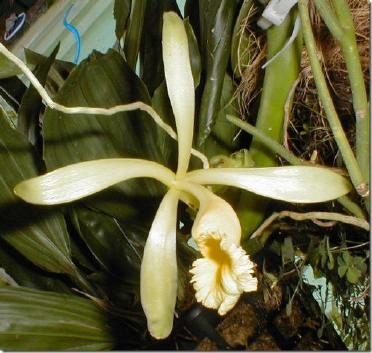
The scent of vanilla is my absolute favorite. I even have vanilla scented cologne. Who would not want to smell this wonderful scent? Cooks and bakers know the familiar and essential ingredient, vanilla extract, comes from a vanilla bean. But, did you know that the vanilla bean is actually the seedpod of an orchid? It is the orchid known as Vanilla
planifolia. The word "vanilla" actually is a Spanish word meaning "long pod", referring to the seedpod. It is the only orchid used in the food and cosmetic industry.
The first reference to vanilla dates back to 1552 when it was documented in a manuscript as being used to flavor a cacao beverage we know today as chocolate drink. Also during that time it was used in perfume and body lotions. Widely cultivated today, vanilla orchids are offered at orchid society shows and sales, through orchid magazines and
online.
The vanilla orchid is monopodial in that it grows via long vine-like shoots having flat, long succulent leaves. Like many orchids, it is an epiphyte, meaning that it lives on a tree without drawing any nutrients from the tree. Commercial vanilla plantations require tree plantings for the orchids to climb. The vine climbs up the tree in a zigzag
fashion. Each blooming section can bear one to two dozen creamy blooms. As many as several hundred flowers can appear on a mature orchid plant.
In its native habitat, a mature vanilla orchid can grow to 300 feet or greater. In a greenhouse a vine can be kept to a manageable 20 feet. The vanilla orchid grows best in bright filtered shade with high humidity. Ideal temperatures are between 60 and 70 degrees F at night, and 80 to 95 degrees F daytime.
 Each orchid flower opens for only one day. If pollination does not occur, the flower is dropped. The flowers are self-fertile but need bee and hummingbird pollinators to perform this task. Hand pollination is the most reliable method for commercially grown vanilla and for home orchid
growers. The flowers are quite large with white, greenish yellow or cream colors. Most flowers have a sweet scent.
Each orchid flower opens for only one day. If pollination does not occur, the flower is dropped. The flowers are self-fertile but need bee and hummingbird pollinators to perform this task. Hand pollination is the most reliable method for commercially grown vanilla and for home orchid
growers. The flowers are quite large with white, greenish yellow or cream colors. Most flowers have a sweet scent.
The vanilla seedpod usually is called a "vanilla bean" although it is not a true bean. Typically the seedpod is 4 to 8 inches in length. After flowering and pollination, it ripens gradually over 8 to 9 months, eventually turning black and giving off a wonderful strong aroma. Each pod contains thousands of minute seeds. Both the pods and seeds are
used to create vanilla flavoring. A vanilla seedpod is dehiscent, meaning that it naturally splits apart along either side. Home cooks are very familiar with this attribute since it easily enables the scraping out of the tiny seeds used in recipes.
The long orchid maturity and intensive labor required for commercial production add to the expense of pure vanilla extract making it the second most expensive spice after saffron. Pure vanilla extract is an extremely complicated ethanol extract of several hundred naturally occurring different fragrant chemical compounds. Imitation vanilla extract
is an ethanol mixture of usually one synthetic chemical known as vanillin acetate (processed from wood waste or by chemical synthesis). Some cooks prefer the more complex flavors of pure vanilla extract to that of less expensive imitation vanilla. Others claim there is little difference in this often-debated subject.
The home vanilla orchid grower must provide the orchid vine with sturdy support. The vanilla orchid needs to be fertilized every two weeks during the spring and summer with an orchid fertilizer and misted regularly in an effort to keep an 80% humidity level. It takes approximately 3 to 5 years from cutting to obtaining a bloom. The flowers need to
be hand-pollinated in the morning with a fine brush or toothpick. If pollination is successful, the orchid will produce green bean-like pods from October through March. Good quality pods should be at least 6 inches long. Pods are ready for harvest in 8 to 9 months.
The pod curing process is labor-intensive and involves sweating and drying of the beans. Every day for 6 weeks, one must wrap the beans at night to facilitate moisture condensation on the pods. During the day the beans should be placed on trays in the sun or under a heat lamp indoors. Following this sweating process, the now brown and shriveled
pods need to be placed in a dark, dry place for an additional 3 months. Cured beans can be stored in an airtight container indefinitely or can be mixed with ethanol (drinking quality 190 proof) and allowed to sit several weeks to develop the vanilla extract. After all this attention and tedious work, it is certainly easy to understand why pure vanilla extract is the
second most expensive spice available today.
Read other articles on growing herbs or spices
Read other articles by Connie Holland